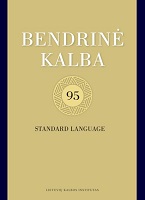Prijungiamasis ryšys sovietų okupacijos laikų lietuvių sintaksės darbuose
Subordination in the Works on Lithuanian Syntax in the Years of Soviet Occupation
Author(s): Artūras JudžentisSubject(s): Morphology, Syntax, Semantics, Baltic Languages, WW II and following years (1940 - 1949), Post-War period (1950 - 1989)
Published by: Lietuvių Kalbos Institutas
Keywords: subordination; agreement; government; adjunction (šliejimas); Vytautas Ambrazas; Jonas Balkevičius; Pranas Gailiūnas; Zelma Dumašiūtė; Česys Grenda; Bronius Kalinauskas; Vitas Labutis; Vytautas Sirtau
Summary/Abstract: The article analyses, how the types of subordination are described in the works on Lithuanian syntax, during the Soviet occupation, during the years between the middle of the 20th century ant the end of eighties. The investigation opens with the Grammar of the Lithuanian language (1945) by Juozas Žiugžda and ends with the manual for higher schools Syntax of the Lithuanian language (1988) by Vytautas Sirtautas and Česys Grenda. Initially, under conditions of occupation school grammar continued the traditions of syntax of independent Lithuania and distinguished only two variants of subordination – agreement and government. This tradition was continued in the works of the ideologue of the occupation regime Juozas Žiugžda. It was only when Pranas Gailiūnas came to Žiugždaʼs help that the three-variant model of subordination, which had already been adopted in scientific works from Russian linguistics, was applied to the school. Bronius Kalinauskas, a lecturer at the Pedagogical Institute, transferred the three-variant Russian syntax model to Lithuanian in the 1960s and early 1970s. Pranas Gailiūnas took over this model from him (or directly from the Russian linguistics) and applied it to secondary, and Jonas Balkevičius – to high school. In Kalinauskasʼ works we also find many differences in the types of subordination (full and partial agreement, strong and weak government, full and partial adjunction), that are most likely taken over from Russian linguistics. Their analysis in later works of Lithuanian syntax has largely defined the field of consideration in this area of grammar. Subordinate syntactic relations were described in works on syntax of two directions during the considered period: as one of the characteristics of the parts of sentence (Žiugžda, Sirtautas), and as the structural basis of word groups (Kalinauskas, Balkevičius, Labutis and Valeckienė). Only in the Grammar of the Lithuanian language, edited by Vytautas Ambrazas (1985), was more clearly turned in the direction of merging both directions. Throughout the considered period, syntactic relations were not distinguished from semantic relations (this is especially obvious when defining the relation of government). And only at the very end of the period (in the article of Vytautas Ambrazas) did these shortcomings of the description of syntactic relations begin to be realized, and an attempt was made to clearly distinguish between syntactic and semantic units. However, the syntactic level of analysis continues to be confused with the morphological (expression) level (agreeing in gender, person, number; governed inflections), both of which are considered as surface levels of language. Already at the beginning of the twentieth century agreement was perceived as the alignment of morphological forms, rather than semantics or syntax. Later, it became known as a variant of a syntactic subordination, without delving into the semantic relationships that this connection conveys. In essence, this multifaceted concept, first merging semantics and morphology, later on – and syntax, has survived throughout the twentieth century and in part continues to this day. Government in independent Lithuania was defined as a semantic relationship, and in the first decades after the war it was generally perceived in a similar way. Nevertheless the semantic (later on and syntactic) nature of the relationship was fused to its morphological expression. At the early period of occupation, agreement and government were associated with the study of word groups, as they made the basis for their structure. Adjunction (šliejimas) in Lithuanian linguistics was singled out as a semantic (later on and as a syntactic) relationship of words that is not expressed by means of morphology. So it was based on surface expression (or not-expression, exactly) only and didnʼt have any distinct syntactic content. The article analyses, how the types of subordination are described in the works on Lithuanian syntax during the years of Soviet occupation – approximately between the middle of the 20th century ant the end of eighties. The investigation opens with the Grammar of the Lithuanian language (1945) by Juozas Žiugžda and ends with teaching aid for higher schools Syntax of the Lithuanian language (1988) by Vytautas Sirtautas and Česys Grenda. Initially, under conditions of occupation school grammar continued the traditions of syntax of independent Lithuania and distinguished only two variants of subordination – agreement and government. This tradition was continued in the works of the ideologue of the occupation regime Juozas Žiugžda. It was only when Pranas Gailiūnas came to help for Žiugžda that the three-variant model of subordination, which had already been adopted in scientific works from Russian linguistics, was applied.
Journal: Bendrinė kalba (iki 2014 metų – Kalbos kultūra)
- Issue Year: 2022
- Issue No: 95
- Page Range: 133-161
- Page Count: 29
- Language: Lithuanian

